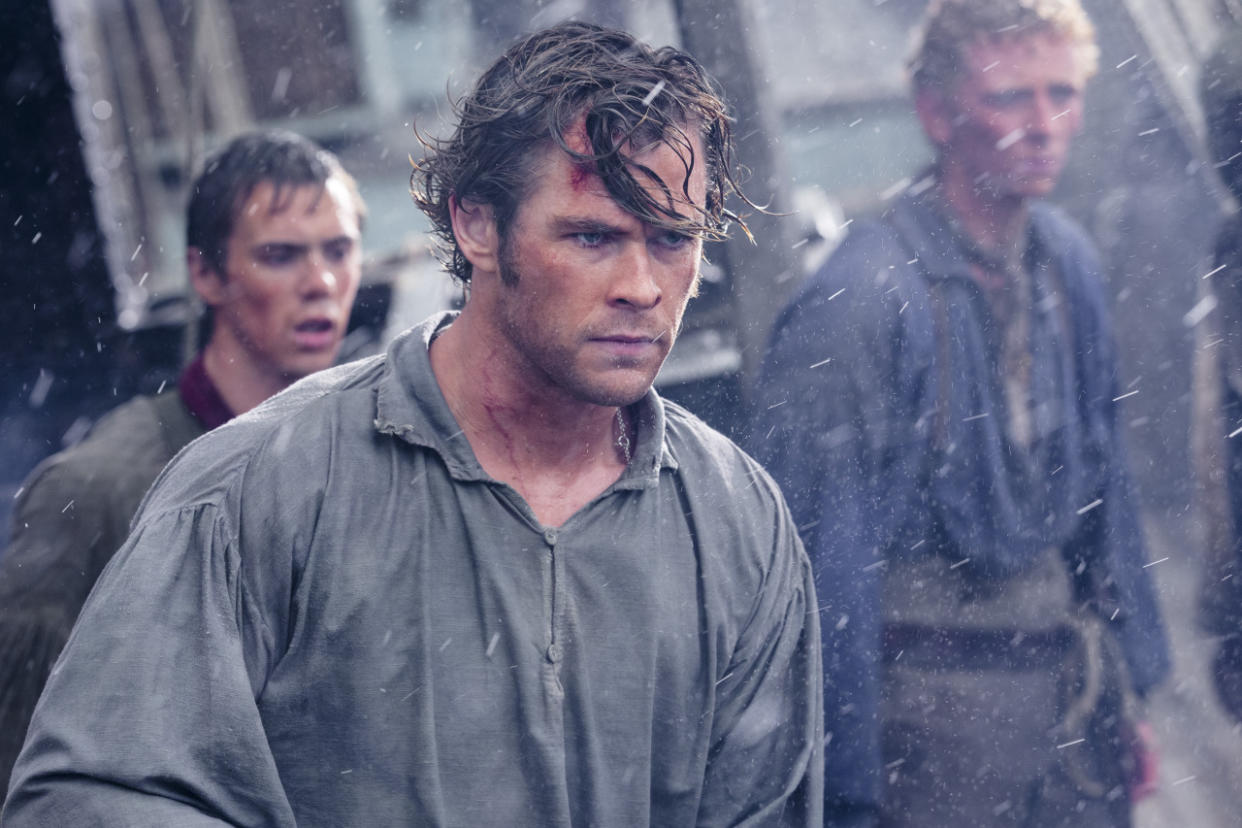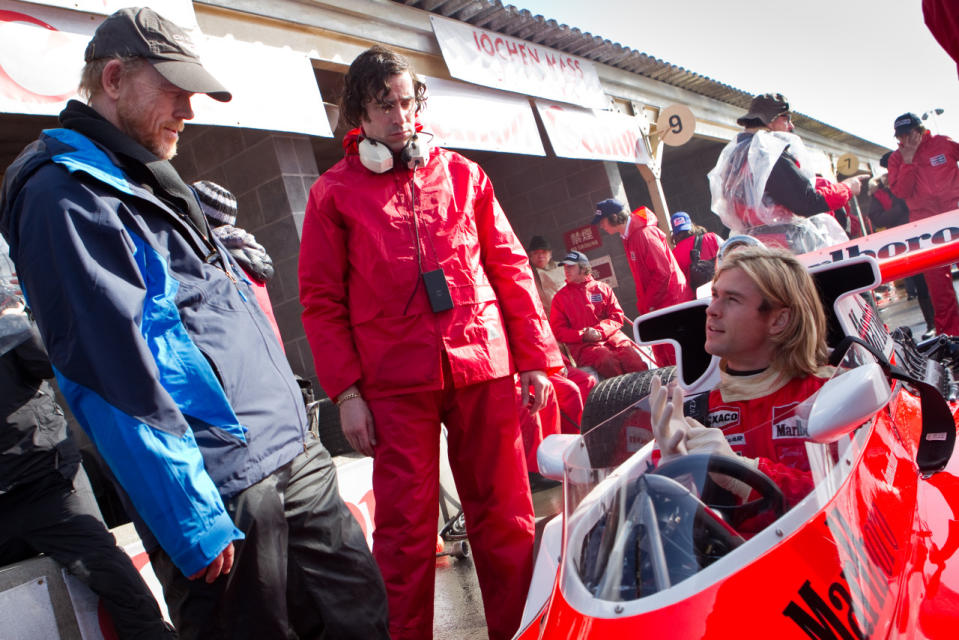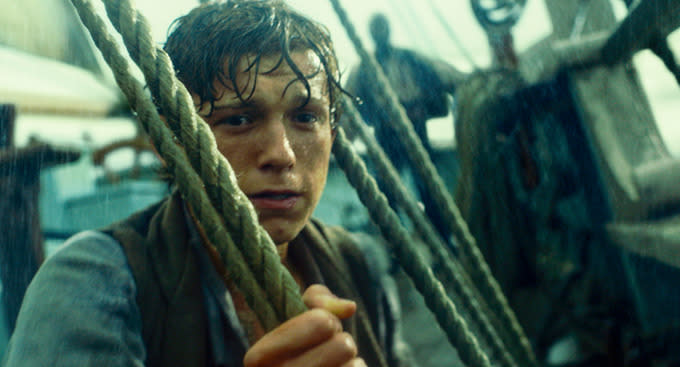Low Calories, Superheroes, and Killer Whales: On the London Set of 'In the Heart of the Sea'

It only took Chris Hemsworth a four-day span — and a flight halfway across the globe — to experience both the glamorous highs and gloomy lows of being a major action star. On a warm Monday night in November, 2013, the Australian-born actor was all smiles and laughs as he strolled the red carpet and soaked up the love for Marvel’s Thor: The Dark World at its Hollywood premiere. By Friday, though, he was trudging around a chilly, rainy, and muddy England set — hungry, tired, 30 pounds less than his usual godly Norse mass, and dreading the fact that he has to drop even more weight — filming the true-life whaling adventure, In the Heart of the Sea.
“It’s not ideal,” Hemsworth told press visiting Warner Bros. Studios, Leavesden in southeastern London, where he stood among about 350 extras dressed in colonial New England garb and in front of a giant water-tank that housed the film’s iconic (and ill-fated) ship, the Essex, about the “schizophrenic” nature of promoting one movie while filming another. Especially when the movie you’re filming has a story as intense and dire as In the Heart of the Sea.
Based on Nathaniel Philbrick’s 2000 National Book Award-winning nonfiction title and adapted for the screen by Charles Leavitt, the Ron Howard-directed film tells of the infamous 1820 whaling mission that ended in disaster when the Essex was attacked and decimated by a vengeful sperm whale. The crew, including Captain George Pollard (Benjamin Walker), first mate Owen Chase (Hemsworth), and cabin boy Thomas Nickerson (Tom Holland), was forced onto tiny whaleboats where many died and those who survived resorted to cannibalism. The survivors’ account of the ordeal inspired Herman Melville as he penned his summer-reading-list classic, Moby-Dick.
Hemsworth, Howard and company gave us the full skinny on the film, which you can read in five easily digestible bites below:
About that crazy weight loss…
Hemsworth tweeted a photo of himself in Sea mode — looking unshaven and frighteningly emaciated — that quickly went viral last month. At the time of our set visit in late 2013, the Avengers star had already dropped 30 pounds from his usual 215-pound Thor frame, and was consuming around 1,000 calories per day. He and his co-stars would soon be down to a mere 500 calories per day, less than what most of us consume for lunch. “It’s the second time I’ve done it, both times with Ron,” said Hemsworth, who also lost 30 pounds for the 2013 drama Rush. “Maybe he’s got some obsession with me being skinny.”
And fatigued. “We’re on low carbs, which means we sleep all the time,” explained Holland, who had a previous brush with aquatic disaster in The Impossible and who recently won the prized role of the new Spider-Man. “I was just off-set for 20 minutes and I fell asleep on a concrete floor with a coat as a mattress.” And also ill-tempered: “We’re all losing weight and we’re all getting slightly more and more grumpy every day,” Holland added. “But what’s great is because we’re all doing it together, we understand when some people are having an off day. You can tell in the morning, like, ‘Oh man, he missed breakfast.’”
Asked if the hunger can power his performance, Hemsworth laughed. “If I need to be agitated or angry or frustrated or depressed or moody, yeah, sure,” he said. “You don’t have to convince yourself that you’re exhausted and hungry, you feel it.” Still, it was clear that despite their hunger, fatigue, and mood shifts, the actors were keeping everything in perspective. “It’s kind of lame to complain about it considering there are actual people starving around the world, and we just have to eat quinoa every once in a while,” said Walker (Abraham Lincoln: Vampire Hunter). “Uptown problems.”
Just tried a new diet/training program called “Lost At Sea”. Wouldn’t recommend it.. #IntheHeartoftheSea pic.twitter.com/y89McNuiiV
— Chris Hemsworth (@chrishemsworth)
Like most true-life stories, the movie veers from its source material.
Though the story of the Essex influenced Melville’s writing of Moby-Dick, the incident had largely been a footnote in the novel’s backstory. But Sea is framed by scenes that portray an older Nickerson (played by Brendan Gleeson) recounting the voyage’s horror directly to the author (Ben Whishaw) in 1850. “The story between Melville and the old Nickerson is in itself a compelling story of a writer coming to find a theme that he wants for his own masterpiece, or what turned out to be his masterpiece,” said producer Paula Weinstein (Blood Diamond). Weinstein clarified that Nickerson never met Melville in real life, but that the author met Chase’s son, who gave him his father’s published account of the story, Narrative of the Most Extraordinary and Distressing Shipwreck of the Whale-Ship Essex (1821). Howard noted that Melville didn’t include his central human character, Ahab, in initial drafts, but added him after hearing of the Essex.
Other differences from Philbrick’s narrative are more nuanced. The film doesn’t spend nearly as much time focusing on the inland Nantucket community, for instance, which is painted in a vividly historical context in the book. And some of the relationships among the vessel’s crewmembers are tweaked as well, mostly notably that between Walker’s Captain Pollard and Hemsworth’s first mate, Chase. In the book Pollard becomes somewhat submissive as Chase eventually takes control of the crew, whereas things are decidedly more heated between them in the movie. “In our version we take creative license and there’s a lot of friction between the two of them from the get-go,” Hemsworth said. “These guys [are] in conflict, but underneath there’s an amount of respect,” added the actor, who compared their rivalry to that of his character James Hunt and Niki Lauda (Daniel Brühl) in Rush. And speaking of Rush…
Rush made it all possible, and Sea is its spiritual sequel.
Like many high-profile Hollywood projects, Sea went through the development rigmarole for several years before it finally got made. Weinstein, who initially partnered with Barry Levinson on the project before he exited, put that number at 12. But the key players all came together after the completion of Rush, the acclaimed gritty drama about 1970s Formula One racing stars helmed by Howard. Hemsworth was attached to Sea at the time, but the film didn’t have a director. After Hemsworth’s manager, Will Ward (also a producer on Sea), saw an early cut of Rush, he called Howard immediately, “not thinking in a million years we could get him to do it,” Ward said. “He graciously agreed to do it and then once he realized it was all based on real people and a true story, it really piqued his interest, and in a couple weeks he came on.”

Howard and Hemsworth were eager to reunite (“The great thing is we have shorthand now,” the actor said), but the director also brought with him his Rush cinematographer Anthony Dod Mantle (who won an Oscar for Slumdog Millionaire) and longtime editors Daniel P. Hanley and Mike Hill (Oscar winners for Apollo 13), and had his Rush and Frost/Nixon writer Peter Morgan (who is uncredited) do some touchups on the script. It’s also the director’s second film he shot digitally, after Rush.
“In odd ways, Rush and In the Heart of the Sea are related,” Howard said. “Two different worlds, obviously but they offer similar things. They have the possibility of transporting audiences in a very cinematic, modern, compelling way that’s fresh, and invites people to see it on the big screen.” They’re also connected “in terms of heart and mind,” the director thinks. “With Rush, it was that question of how far you push yourself in any field or endeavor if you’re really trying to excel… And in this one, it’s much more about coping, testing yourself, how individuals cope with those tests.”
The movie proves that 19th century whalers were some tough SOBs.
Even before they’re terrorized by that whale, the Essex crew was already susceptible to the risks and hardships that came with the treacherous missions of the industry in the 19th century. Men typically left their families for years at a time, feasted on hardtrack (“it’s like eating a brick,” Holland said of the type of cracker known as “ship’s biscuit”) and harpooned 60-foot whales from tiny boats; it was commonplace for there to be casualties along the way. “It was incredibly taxing,” Hemsworth said. “It wasn’t swashbuckling, skipping off to sea… It was hardcore and [similar] to going off to war. You didn’t know if you were coming back, and you were gone a long, long time.” Said Ward: “You look at what people we consider to do tough jobs today, and there’s nothing I can think of that compares to that.”

“It was a crazy, crazy life these guys had,” added Holland, especially for the cabin boy. “I get all the worst jobs aboard the ship… And a lot of the time I’m covered in whale oil, or I’m wet-through, or I’ve got barely any clothes on because all my older mates have stolen them.”
It does help to be the man in charge. “I just boss people around,” Walker laughed. “I met a real captain in Cornwall and I said, 'What’s your biggest challenge as captain?’ And he said, 'Well, sometimes I get a blister right here on my finger from holding my coffee mug.’” Of course that’s all before the eating of one another and what not. “That’s all anybody wants to talk about!” Walker lamented. Anticipating the grotesqueness of the cannibalism scenes, though, the actor was upbeat: “I think we’ll be so hungry at that point that I can fake it pretty easily.”
The whale is a “sociopath,” and kind of like Clint Eastwood.
No actual whales were harmed in the making of In the Heart of the Sea, because the massive sea mammal is represented almost entirely in CGI. Though they did have a life-sized prosthetic version of it on set, and its sheer giganticism was a shock to the senses for the actors. “All of us were like, 'That must be fake, that can’t be the real size,’” Holland recalled. “It’s ridiculous.”
Ward said the target, as far as seamlessly blending a CGI animal into the fabric of a nautical environment, was the tiger in Ang Lee’s Life of Pi. “[It needs] to be up to those standards,” he explained.
Describing the temperament of the whale, visual effects supervisor Jody Johnson (who of course also worked on Rush), provided a colorful comparison: “He’s a bit of a high-plains drifter,” he said. “He’s quoted as being a bit like Clint Eastwood. He’s a sociopath.”
Asked what they refer to the whale on set as, the answer was obvious. “Moby,” Johnson said.
In the Heart of the Sea opens Dec. 11. Watch the trailer:

 Yahoo Movies
Yahoo Movies 

